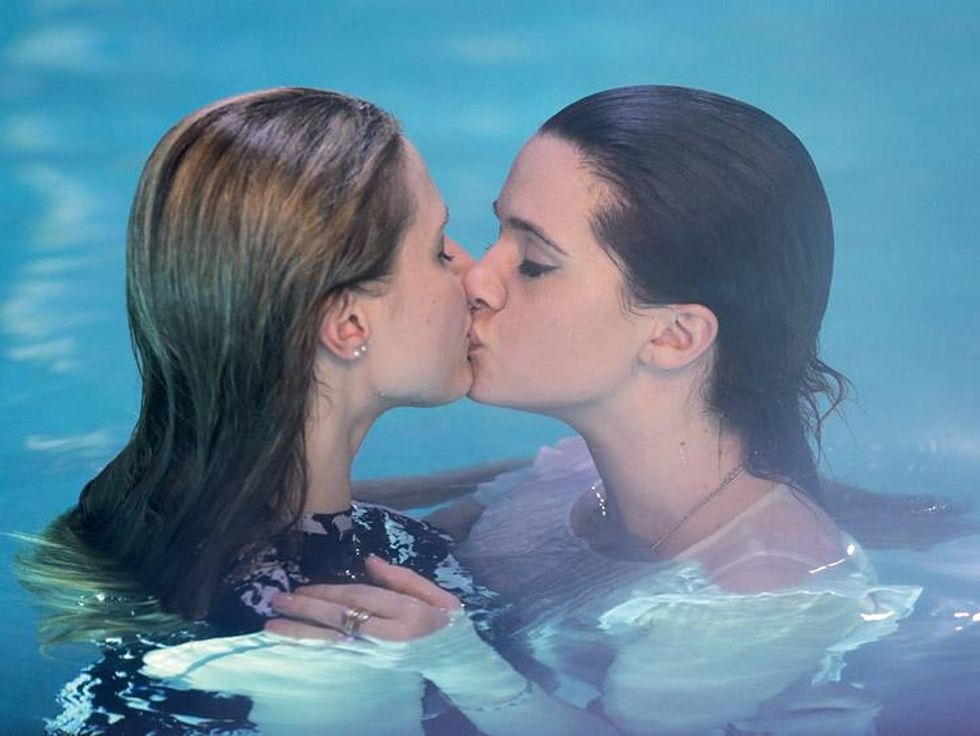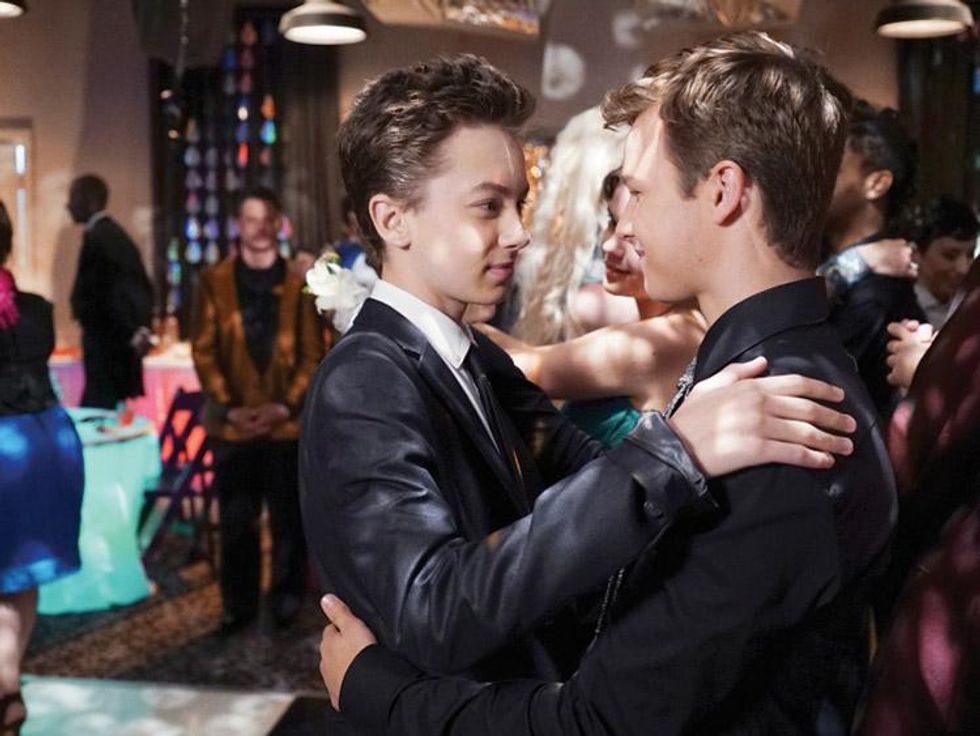In March 1994, America freaked out when two women kissed on prime-time television. After word leaked that Roseanne would include a scene in which a lesbian, played by Mariel Hemingway, planted a lip lock on the titular character, conservative groups protested, advertisers balked, and ABC decided not to air the episode. It took an angry Roseanne Barr threatening to take the show to another network to make ABC relent, although it felt the need to precede the episode with a stern parental advisory.
In March 2016, few people even noticed that ABC had two shows in its lineup focused on the lives of gay teenagers: The Real O'Neals, a sitcom about a Catholic family's response to 16-year-old Kenny O'Neal's coming out, and the drama American Crime, which in its second season showed the devastating psychological damage familial and peer-group homophobia can inflict on gay high schoolers.
The transformation of American attitudes toward homosexuality over the past 22 years is encapsulated in those contrasting reactions. Whereas a brief and thoroughly unsexy kiss between two adult women (Barr winced and wiped her mouth on Hemingway's sleeve after they uncoupled) was once thought too hot to broadcast, we now live in an era when the TV schedule is jam-packed with nuanced depictions of gay teens. In 2015, The Fosters -- a cable show about a married lesbian couple and their five children (it's hard to imagine anyone would've predicted that show existing in 1994) -- featured a smooch between two 13-year-old boys, and the most common response was to note what a cute couple they made.

Katie Steven and Rita Volk in Faking It (MTV)
And these aren't the only gay, lesbian, bisexual, and transgender teens on television today. The CW's cult sci-fi drama The 100 has featured several queer teenagers, including some who are both sexually active and leaders of their communities. On Freeform's Pretty Little Liars, one of the four eponymous fibbers is a lesbian, and she's just as conventionally attractive, smart, and completely messed up as her BFFs. MTV's Faking It started with the bizarre premise that at a liberal high school in Austin, Texas, two girls would pretend to be a couple for the social cachet lesbianism famously imparts, but by the second season it had evolved into a complex exploration of sexual identity, as well as a reliable source of hilariously bitchy put-downs from Shane, the girls' out, proud, and popular pal.
It's no coincidence that many of those programs air on networks that explicitly target younger viewers. Since the days of earnest after-school specials, didactic TV shows aimed at teens have obsessed about helping young people work through their issues. In the mid-2000s, the biggest hits on The N -- a Nickelodeon channel aimed at "tweens" -- were South of Nowhere and Canada's Degrassi: The Next Generation, which could just as easily have been called High Schoolers With Big Problems. Both featured queer or questioning kids, along with teens with body issues, crummy parents, and addictions. But because the joy of falling in love was clearly distinct from nightmares like living with a violent parent or developing a drug problem, these shows put sexuality into perspective -- the problem wasn't being gay, it was getting parents and bigoted classmates to keep their dumb ideas to themselves.
For many people, the ur-gay TV teen will always be Rickie Vasquez from the tragically short-lived 1994 series My So-Called Life. Rickie, played with heartbreaking sensitivity by Wilson Cruz, was a gentle, eyeliner-wearing lad, happiest when hanging in the girls' bathroom with his friends Angela and Rayanne. And thank God for those friendships, because Rickie was otherwise alone in the world, having been kicked out of the house by his abusive guardian. In one episode, Rickie allowed himself to believe that a guy he had a crush on had agreed to go to a school dance with him, only to realize that the kid, totally oblivious, was interested in Rayanne. Rickie could only conceive of finding love and happiness "in some imaginary universe that exists in my mind." It was a hard life, but an extraordinarily sympathetic one.

Hayden Byerly and Gavin MacIntosh in The Fosters (Freeform)
Unlike Rickie Vasquez, Ugly Betty's Justin Suarez had a doting mother and a loving family. Justin (and Mark Indelicato, who played him) was just 12 when Ugly Betty premiered in 2006, and while the show was careful not to sexualize the character, the fashion- and musical-theater-loving preteen was always unapologetically flamboyant. While Justin's mother sometimes wished he were more like a "normal" boy -- to spare him the harassment he sometimes endured -- she supported him unreservedly, telling his estranged father, "He's comfortable with who he is, and so am I." In the fourth and final season, Justin officially came out as gay, to the surprise of absolutely no one in the close-knit Suarez clan or the viewing public.
Speaking of musical theater, I am convinced that six seasons of Glee did more to normalize homosexuality than any other show in TV history. For most of its run, tens of millions of people -- almost 27 million for the episode that aired after the 2011 Super Bowl -- gathered in living rooms across America to watch a show in which gay and gender-nonconforming characters ruled the roost.
Sure, in Glee's earliest episodes, fey Kurt Hummel was cruelly bullied by the jocks at McKinley High, but by the show's final days, the most popular characters -- or at least those with the best lines -- were the ones in happy, loving, same-sex relationships. Glee's writers clearly knew how influential they were: In the final season, a brash young football player declared, "Positive representations of gays in the mass media have given me the confidence I need to be myself, which, it turns out, is kind of an arrogant jerk." But even an arrogant jerk like Santana Lopez was hurt by her grandmother's refusal to attend her wedding to Brittany S. Pierce. Brittany comforted Santana by telling her, "If Abuela gets to know us, and sees we're somewhat normal...maybe she'll understand that, aside from the awesome lesbian sex part, we're just like everyone else." By watching Glee, people around the country also saw how "somewhat normal" LGBT kids are.
The gay TV teens of 2016 are more complicated and more recognizably real than those who came before them. In the devastating American Crime, two young men are grievously wounded by the way family members and fellow students respond to their gayness. The taunts, physical beatings, and wrongheaded moralizing lead both to act out violently. Their actions are brutal and excessive, but the show is careful to indicate that their behavior was on some level triggered by the irrational hatred of their homosexuality.
The delightful Real O'Neals, based very loosely on Dan Savage's early life, is much more playful than American Crime but no less rooted in reality. Episodes tackle head-on the challenges today's teens face when learning about gay life. How should Kenny ask a guy out? How does he cope with being the only out gay kid in Catholic school? Is he a bear, an otter, a wolf, or a chicken? If only he could turn on the TV to learn from his gay teen peers!






































































Charlie Kirk DID say stoning gay people was the 'perfect law' — and these other heinous quotes